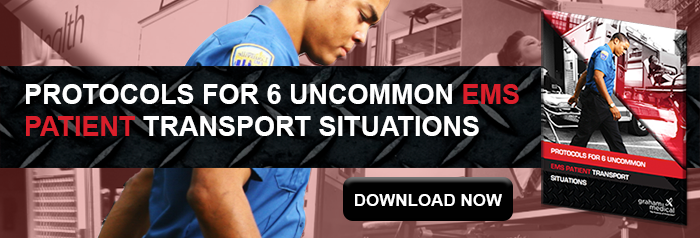 The majority of patient transport is conducted via ground transport, typically in an ambulance. This patient transport is conducted with either basic paramedic protocols or with more advanced life support protocols and medical staff, such as those used in interfacility transport and specialty care.
The majority of patient transport is conducted via ground transport, typically in an ambulance. This patient transport is conducted with either basic paramedic protocols or with more advanced life support protocols and medical staff, such as those used in interfacility transport and specialty care.
The most emergent cases may also be transported via air ambulance or helicopter. Helicopter transport may be used when time is of the essence and providers have designated the terrain to be unmanageable for ground units, the distance too far to navigate based on patient health, or simple speed to be essential.
Preparing for Helicopter Patient Transport
The scenarios that require helicopter transport present different levels of preparation. Most helicopter transport will require similar equipment and protocol training as that of standard ground patient transport including items needed for both basic and advanced care.
These supplies will include standard patient support like wound care supplies and supplemental oxygen, as well as supportive supplies like blankets, sheets, and drapes. Additional supplies may need to be cognizant of limited space and weight requirements for air transport. Invest in compact and sturdy supplies such as a flexible patient transport that is lightweight and requires minimal storage.
Scenarios Requiring Helicopter Transport
Emergency preparedness protocols that indicate the need for air transport based on the time, distance, and services available are essential. Common guidelines designate the use of helicopter medical evacuation services when a patient meets standard transport protocols, and a significant amount of time would be saved when compared to traditional ground transport.
The American College of Emergency Physicians has worked to generate some additional medical guidelines. These guidelines include:
- Patients requiring expeditious and critical interventions
- Unstable vital signs that require the fastest available modality
- Availability of a team that can provide needed intra-transport care
In addition to medical protocols, there are also logistical concerns that may warrant air transport. The distance to high-level trauma centers, especially in remote or distant areas, may require air transport. Accidents that block standard ground transportation through debris and traffic are another consideration. And finally, natural disasters or acts of terrorism may hinder traditional transport due to failing infrastructure or mass casualties.
Have proper protocols in place and be prepared for triage by stocking the correct supplies and providing training in triage for air transportation. Provide both ground transportation providers and air support with the right equipment by contacting the experts at Graham Medical online.

